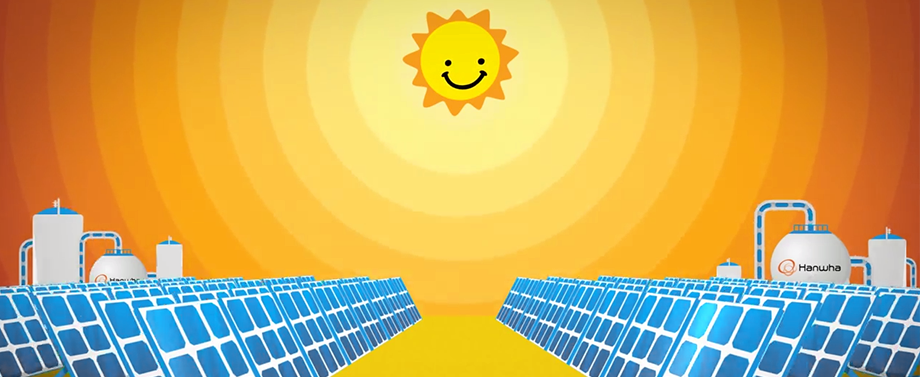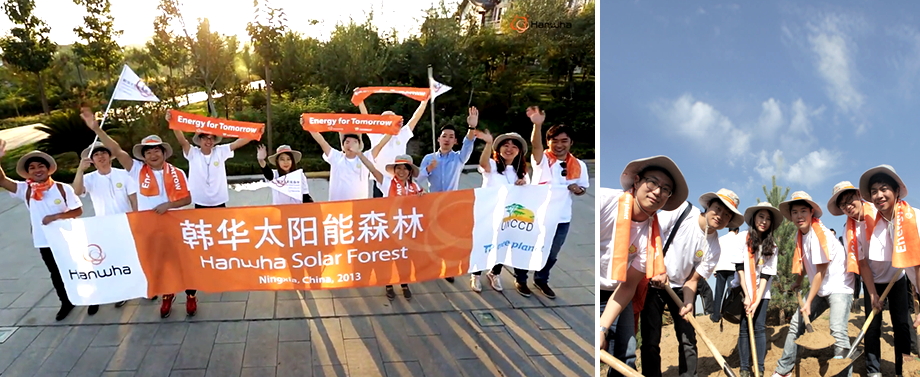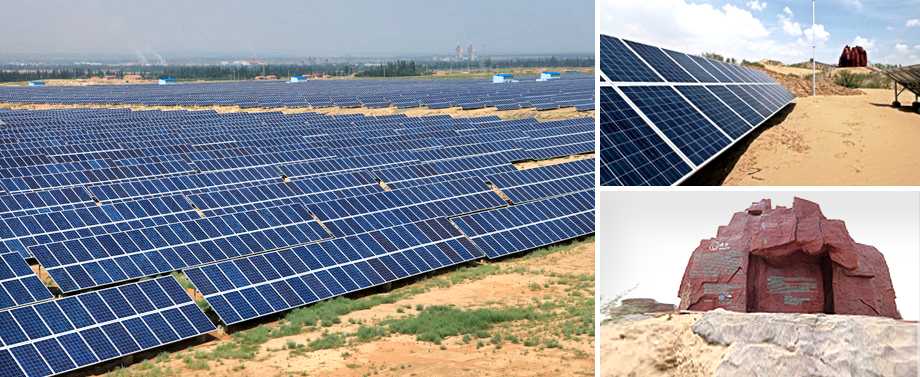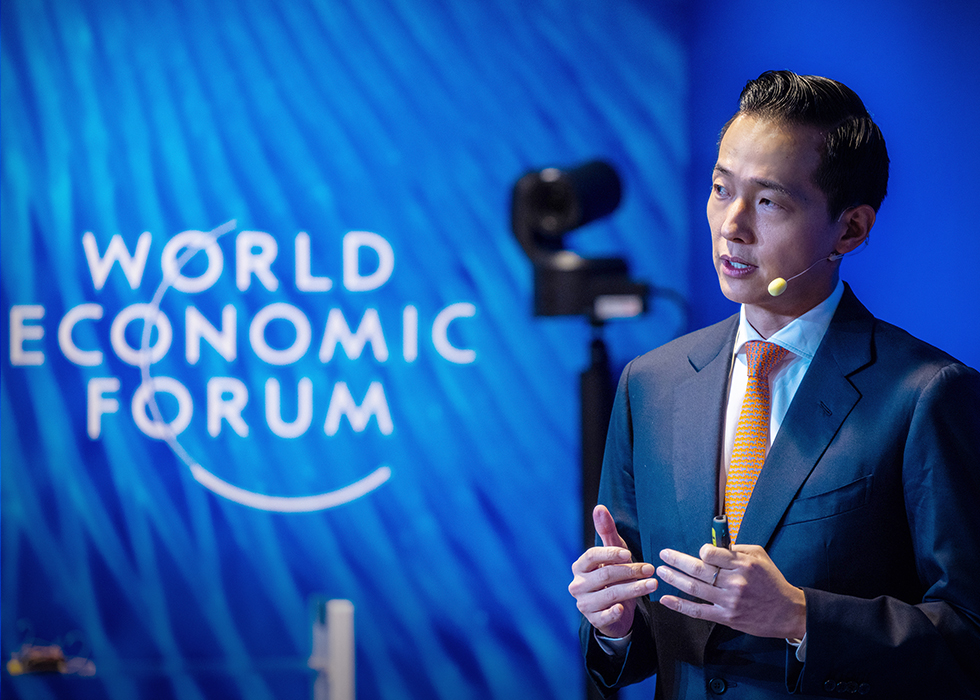The Hanwha Solar Forest : A Smarter Way to Plant Trees to Prevent Desertification
In countries where deserts are not commonplace, ‘desertification’ may sound like a distant issue. However, the situation is much more serious than one may think. Kofi Annan, former UN Secretary General, had once said that one of the most serious problems confronting civilization is desertification. According to a recent report from the UNCCD (United Nations Convention to Combat Desertification), 24 million people in the past 40 years have been forced to leave their homes due to desertification and on top of that, one-third of grain land has become devastated.
In order to help resolve the problem of desertification, Hanwha is staying committed to realizing our mission of addressing climate change, energy depletion and energy poverty challenges. Through efforts such as planting trees and promoting afforestation, we hope to bring positive change to the community. In the longer term, we will also advance clean technologies and promote the achievement of a sustainable, ‘green' future.

What is Hanwha Solar Forest?
Just by tapping away on your smartphone on your commute to work, a tree can be planted and a forest can bloom in the real world.
Hanwha Solar Forest is an innovative campaign, through which smartphone users would plant virtual trees through their mobile devices and in return, Hanwha would plant a real forest in an area stricken by desertification.
The objective of this campaign is not only to increase global awareness, but also to convey a greater meaning to take action for an environmental solution through collective global collaboration.
As a result, Hanwha partnered with Tree Planet to help launch a mobile-based game in 2011 called “Tree Planet,” which is also an official app of the UNCCD. This application allows smartphone users to plant a tree through their mobile devices. To date, two brand new forests, in two different parts of the world, have been planted with the help of Hanwha and the efforts of eager smartphone users.
On September 23, 2013, a tree-planting event celebrating the Hanwha Solar Forest was held in Ningxia for the second time, a region known to be the origin of yellow dust.
The First Hanwha Solar Forest, Tujiin Nars, Mongolia
Mongolia is known to be a region in the world where desertification is the most severe, with a mere 4% of the entire country being forest. In the past 40 years, the average temperature in Mongolia had risen 2 degrees celsius, which is nearly double the world’s average. Due to this climate change, it has been estimated that a total of 1,200 lakes and 900 rivers have disappeared. The impact spreads into the lives of the Mongolian inhabitants, where food is no longer abundant.
It is due to these reasons that Hanwha wished to provide aid to Mongolia.
In 2012, more than 350,000 people participated in this campaign through Tree Planet app. Through this effort, we had planted The First Hanwha Solar Forest, whereby 230,000 virtual trees cultivated were eventually planted in the Selenge Province in Mongolia, and rightfully so.
Within the coming decade, the region is expected to contain a total of 45,600 kilograms of loose soil that would have otherwise polluted the water and air. With the forest now in place, it will protect against water and air pollution, blocking floating dust particles from entering the waters as well as absorbing harmful sulfur dioxide, nitrogen dioxide, and carbon dioxide from out of the air. The forest will continue to grow and its roots will create a strong foundation, which will help to retain an estimated 45,600 hectares of soil from floating adrift.
These are some astonishing figures. Check out our video to witness what can actually be done through the powerful, collaborative efforts of the world’s do-gooders:
The First Hanwha Solar Forest (Video) Tujiin Nars Nature Reserves, Mongolia, 2012
The Second Hanwha Solar Forest, Ningxia, China
In 2013, Hanwha consistently worked toward preventing desertification by deciding to press forward and build The Second Hanwha Solar Forest. The Baijitan National Nature Reserve in Ningxia, China was selected as the site for this project. This region of the world is a source of the severe yellow dust storms that cause serious problems in northeast Asia. With that in mind, the Ningxia site in China earned a special place in Hanwha’s heart for the advancement of The Hanwha Solar Forest Project.
Become familiar with our process by viewing the film below:
The Second Hanwha Solar Forest (Video) Baijitan National Nature Reserve in Ningxia, China, 2013
Since January 2013, more than 300,000 people have contributed trees to be planted within The Second Hanwha Forest. By the end of 2013, a total of 200,000 more trees were planted in Ningxia, China. This initiative will create an 110,000 square meter anti-desertification forest which is expected to absorb 2,470 tons of CO2 over the next 10 years. In addition, it will play an important role in preventing yellow dust storms by holding dust, reducing water runoff and controlling insect populations.

Hanwha Employees Planting Trees in Mu Us Desert
Hanwha is focusing its efforts to create “Energy for Tomorrow,” making the future more vibrant and sustainable for the generations to come. We understand that the global problem of desertification is not something that can be resolved overnight, and that we must continue to look after the world we live in. Hanwha hopes that the global community will continue to pay attention to The Hanwha Solar Forest Project as the initiative has created a new way to fight against desertification by raising awareness on the issue and generating interest through voluntary participation.
Why the Second Hanwha Solar Forest Is Special
100% Sustainable, Solar-Powered Plantation
Hanwha donated and installed an 80kWh solar PV generation facility, manufactured by Hanwha SolarOne, Co. Ltd., to the Baijitan National Nature Reserve in Ningxia, China in 2012, a regional partner of the UNCCD.
Dreaming of a “Zero Carbon Forest”
Hanwha has focused on the situation; Fossil fuels are burned to generate the energy to water the tree plantation. And fossil fuels are one of the main reasons of desertification. Hanwha aimed at reducing the use of fossil fuels by utilizing its solar technology to generate the energy to nurture the trees that are to be planted.
By harvesting trees grown through Hanwha’s solar technology, The Second Hanwha Solar Forest was able to become sustainable and the dream of a “Zero Carbon Forest” can finally come true.
Hanwha finds ways to utilize solar energy to improve the world we live in and bring positive change to the global community by leveraging the advantages of our very own solar energy technologies.
The goal of this campaign is to raise trees without polluting the atmosphere. It was from this notion that solar energy played a big role in this forestry campaign. Instead of burning fossil fuels to generate the energy to water the trees, Hanwha’s solar technology is utilized to create the energy to nurture the trees that are to be planted. Thanks to this eco-friendly facility, The Second Hanwha Solar Forest was able to become a sustainable, zero carbon forest.

Solar Panels Installed in Ningxia, China
Get the latest news about Hanwha, right in your inbox.
Fields marked with * are mandatory.
- Non-employee
- Employee



